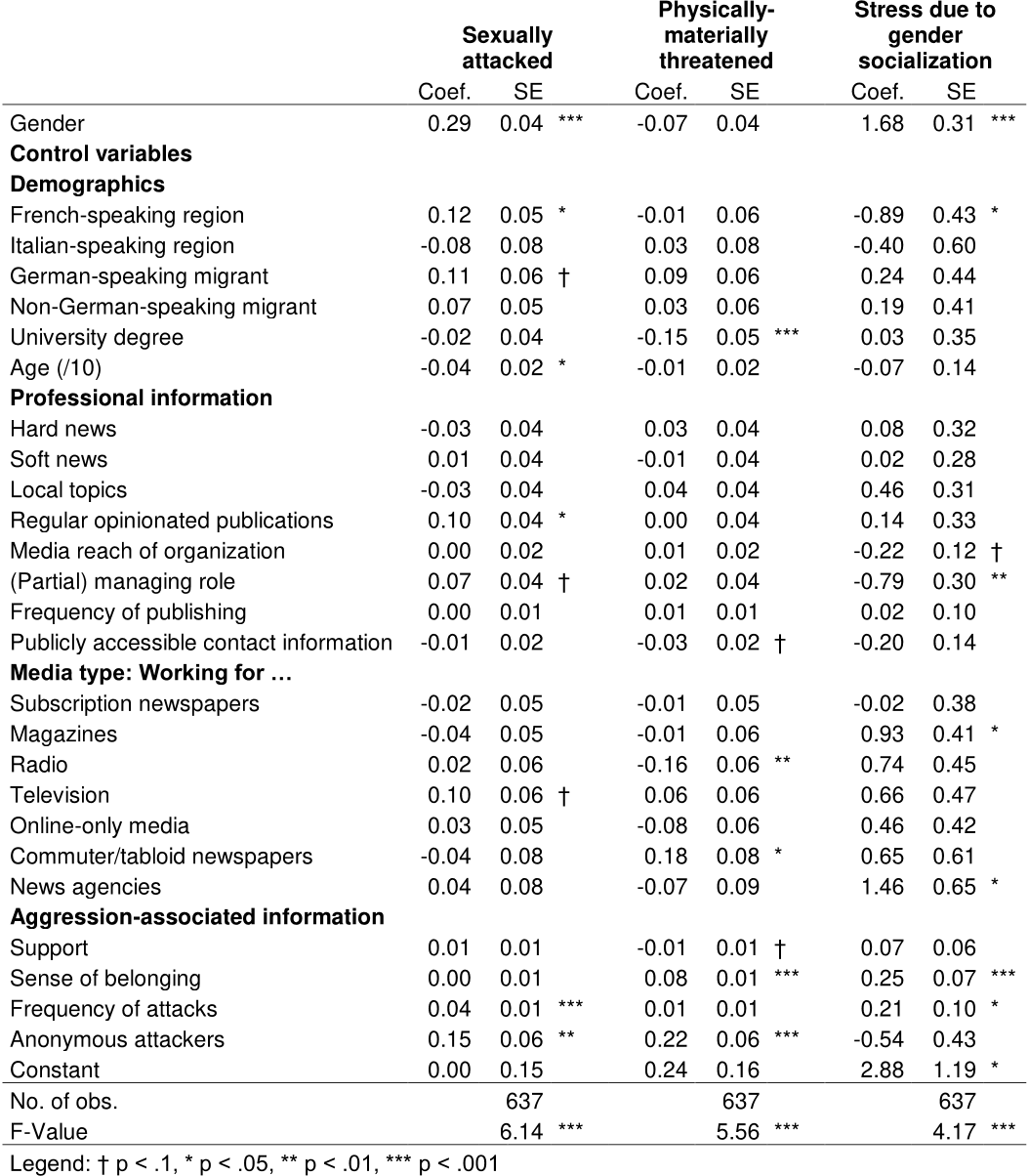
ZurichOpenRepositoryand
Archive
UniversityofZurich
UniversityLibrary
Strickhofstrasse39
CH-8057Zurich
www.zora.uzh.ch
Year:2020
Femalejournalistsunderattack?Explaininggenderdierencesinreactions
toaudiences’attacks
Stahel,Lea;Schön,Constantin
Abstract:Theliteratureonpublicguresattackedbytheiraudiencesisunclearwhyfemaleandmale
guresreactdierentlytoattacks.Thisstudyexamineswhyfemalejournalistsaremorelikelythan
malejournaliststouseavoidancestrategiesasareactiontoonlineattacks. Avoidanceincludeslimiting
audienceengagement,adaptingreportingbehavior,andthinkingaboutquittingjournalism.Drawingon
socialroletheoryandgenderstereotypes,thisstudycontraststwoexplanatoryhypotheses.Theresults,
basedonmediationanalysesofonlinesurveydataof637journalistsrepresentativeofSwitzerland,show
thatwomenaremorelikelythanmentouseavoidancestrategiesbecausewomenaremorestressed
byattacks.Thisheightenedstressisarguedtoresultfromdierencesingenderrolesocialization.In
contrast,whilewomenaresomewhatmoreseverelyattackedthanmen,thiscannotexplaintheirgreater
probabilityofavoidance.Resultscontributeatheoreticallyandempiricallyrichexplanationofgendered
reactionstoattacks.
DOI:https://doi.org/10.1177/1461444819885333
PostedattheZurichOpenRepositoryandArchive,UniversityofZurich
ZORAURL:https://doi.org/10.5167/uzh-182140
JournalArticle
AcceptedVersion
Originallypublishedat:
Stahel,Lea;Schön,Constantin(2020).Femalejournalistsunderattack?Explaininggenderdierences
inreactionstoaudiences’attacks.NewMediaSociety,22(10):1849-1867.
DOI:https://doi.org/10.1177/1461444819885333

Female journalists under attack?
Explaining gender differences in reactions to audiences’ attacks
Lea Stahel
University of Zurich
Department of Sociology
Andreasstrasse 15
8050 Zurich, Switzerland
Tel: +41 44 635 23 17
stahel@soziologie.uzh.ch
Constantin Schoen
University of Zurich
Department of Sociology
Andreasstrasse 15
8050 Zurich, Switzerland
Tel: +41 44 635 23 16
schoen@soziologie.uzh.ch

Abstract
The literature on public figures attacked by their audiences is unclear why female and male figures react
differently to attacks. This study examines why female journalists are more likely than male journalists
to use avoidance strategies as a reaction to online attacks. Avoidance includes limiting audience
engagement, adapting reporting behavior, and thinking about quitting journalism. Drawing on social role
theory and gender stereotypes, this study contrasts two explanatory hypotheses. The results, based on
mediation analyses of online survey data of 637 journalists representative of Switzerland, show that
women are more likely than men to use avoidance strategies because women are more stressed by
attacks. This heightened stress is argued to result from differences in gender role socialization. In
contrast, while women are somewhat more severely attacked than men, this cannot explain their greater
probability of avoidance. Results contribute a theoretically and empirically rich explanation of gendered
reactions to attacks.
Keywords
Coping, gender, journalists, online attacks, social role theory, socialization, survey

Introduction
In today’s media-permeated societies, public figures are regularly harassed by their audi-
ences, but not all of them seem to be equally impacted. Generally, public figures such as
politicians, celebrities, popular academics, and journalists have become highly exposed
and accessible. This has made them easy targets for shaming, defamation, and trolling
(Barlow and Awan, 2016; Johnen et al., 2018; Preuss et al., 2017; Shin et al., 2017).
Some of them regularly receive large amounts of vulgar, pathologizing, inappropriately
generalizing, disparaging, offensive, and threatening feedback against either them or
their work (called attacks in the following). They are attacked through letters, face-to-
face, and these days overwhelmingly online, such as on social networking sites, in
emails, and in comment sections. The existing anecdotal evidence on attacked public
figures emphasizes the negative impact of such attacks on the targeted individuals and on
society at large (e.g. Astor, 2018; Barlow and Awan, 2016; Eckert, 2018). Most of this
evidence, though, is limited to attacked women. For example, among journalists, it is
predominantly female journalists who report avoiding attacks by closing their social
media accounts or stopping writing for the public, and, thus, self-selecting out of the
public sphere (Adams, 2018; Chen et al., 2018; Friedersdorf, 2014; Sletvold Øistad,
2015). Similar accounts by men are rare. Combined with other evidence showing that
online harassment generally affects women more strongly than men (Kenski et al., 2017;
Pew Research Center, 2014), this suggests that female public figures might be more
likely than male public figures to use avoidance strategies as responses to attacks.
However, the existing literature on attacks against public figures and journalists spe-
cifically (e.g. Barlow and Awan, 2016; Johnen et al., 2018; Preuss et al., 2017; Shin et al.,
2017) to our best knowledge includes no systematic research on whether women are
indeed more likely than men to react to attacks with avoidance. Furthermore, the litera-
ture neither argues theoretically nor shows empirically how such gender differences
among public figures could be explained. Filling these research gaps is, though, both
important and timely. New research may theoretically clarify and differentiate the thus-
far inconclusive gendered dimension of attacks on public figures. Also, knowledge about
any gendered avoidance may clarify long-term consequences, such as any reduction in
the diversity of people and perspectives in the public sphere (Adams, 2018; Craft et al.,

2016; Nielsen, 2014).
Thus, the present study examines why female journalists might show different avoid-
ance behavior from male journalists as a reaction to attacks. We use the literature on
coping (e.g. Chen et al., 2018; Fox and Tang, 2017; Leets, 2002) to examine journalists’
responses to attacks. We focus on three forms of avoidance: limiting engagement with
one’s audience, adapting one’s reporting behavior, and considering quitting journalism.
To explain the gendered aspect of avoidance behavior, we draw on social role theory and
gender stereotypes (Eagly and Wood, 2011; Prentice and Carranza, 2002). This theoreti-
cal framework is particularly suitable because it contrasts two possible explanations for
gendered behavior. The first is sanction severity (Eagly and Wood, 2011; Prentice and
Carranza, 2002; Rudman et al., 2012; Wenzel, 2004), which allows a focus on the sever-
ity of attacks. It argues that female journalists are more likely to apply avoidance strate-
gies than males because they are more severely attacked. This explanation is suggested
implicitly or explicitly in many anecdotal sources on the topic (e.g. Chen et al., 2018;
Ferrier and Garud-Patkar, 2018; Friedersdorf, 2014; Tofalvy, 2017). The second reason
is the internalization of gender roles (Dedovic et al., 2009; Matud, 2004), which allows
a focus on the stress experienced following attacks. It argues that female journalists are
more likely to apply avoidance strategies than males because they are more stressed by
attacks generally. We analyze online survey data of 637 journalists representative of
Switzerland in a multivariate mediation approach. Our results contribute a theoretically
driven and empirically validated explanation for public figures’ gendered reactions to
attacks to the literature on attacks against public figures.
Research on coping and on gender differences in behaviors
This theoretical section first introduces literature on coping with attacks. It then presents
the theory and reasons for gender differences in behavior—sanction severity and stress
resulting from internalization of gender roles—and how both may lead to avoidance.
This theoretical framework justifies our focus on avoidance as a coping strategy and
explains gendered avoidance behavior among journalists.
Coping with attacks
Individuals cope with attacks in a variety of ways. When individuals are confronted with





